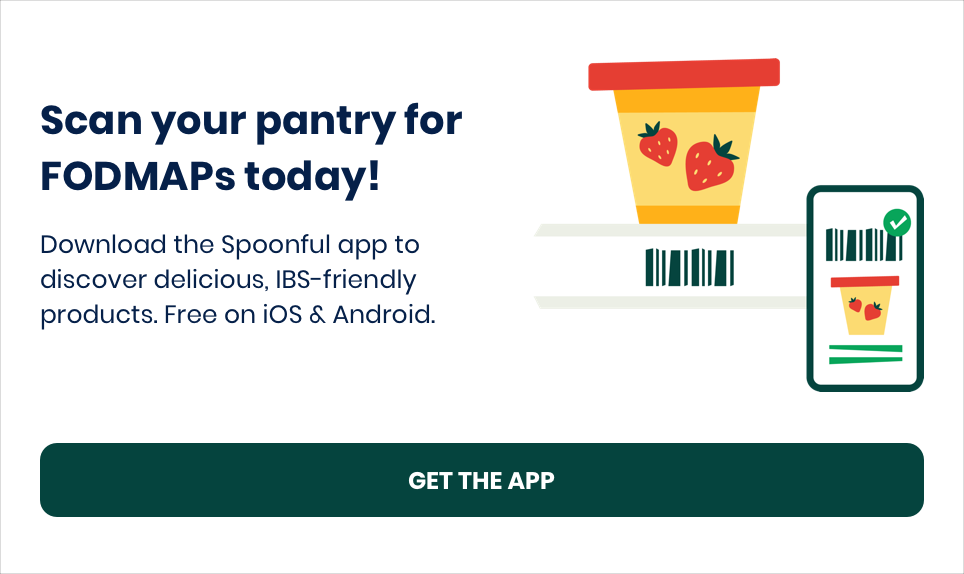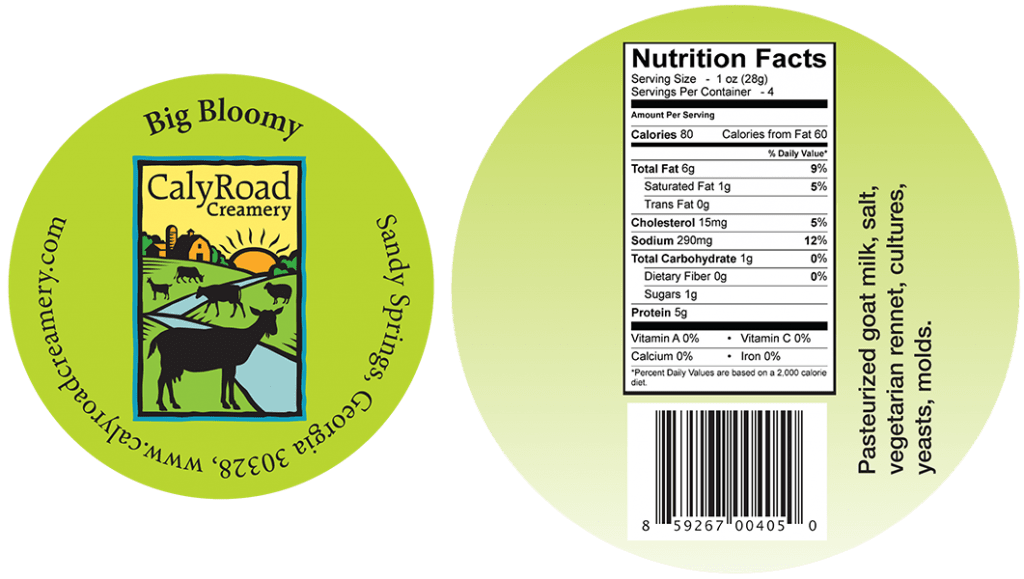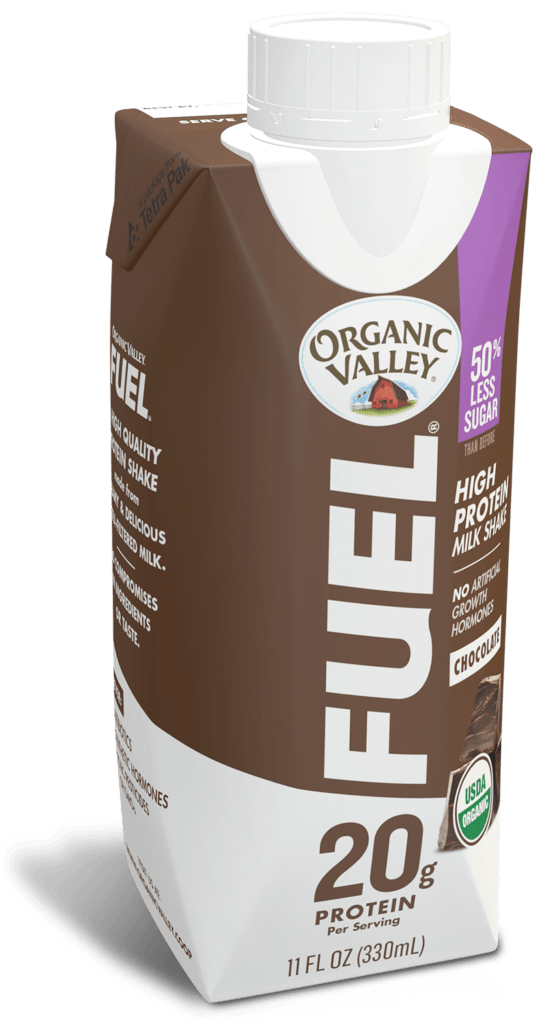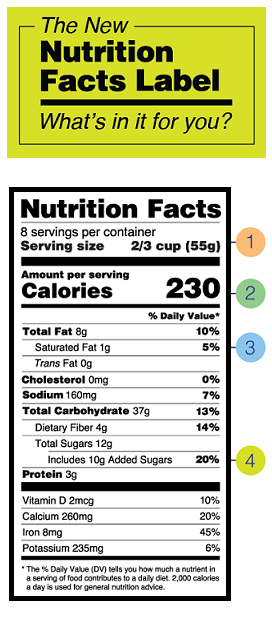Learning to spot IBS triggers on a food label can be challenging and overwhelming. Especially for those who are relatively new to low FODMAP label reading. Many feel they need to have a nutrition degree to understand ingredients, and this confusion intensifies when we add FODMAPs to the mix. As a FODMAP trained dietitian, seasoned gut-friendly shopper, and grocery store curator, I want to help you better understand the food label from an IBS patient’s perspective. I also want to address frequently asked questions and review a few common FODMAP rules we use when assessing an ingredient label.

Getting Started
The Low FODMAP Diet eliminates many trigger ingredients you might find in numerous whole and processed foods as they can lead to IBS symptoms. The Monash app is your best bet to determine the FODMAP content of whole foods like fruits, vegetables, dairy, beans, grains, plus a wide range of snack foods, condiments, and sweets.
When starting the elimination phase, I recommend that you focus on more whole foods (no labels to worry about). Eating a diet rich in low FODMAP fresh fruits and vegetables, lean proteins, eggs, low FODMAP nuts, oats, quinoa, and brown rice can keep things simpler at the beginning. But let’s be realistic, we’re going to want to eat some foods that come in a package, so understanding how to read the food label is an important skill.
Tip: If the product in question has a barcode, scan it with the Spoonful app to determine its FODMAP content. Spoonful is available on both iOS and Android.
Why Read the Food Label?
Unfortunately, many high FODMAP ingredients are added to processed foods as they often add flavor, sweetness, texture, and fiber. Do a quick scan on green-light processed foods in the Monash app to ensure high FODMAP ingredients were not added. As an example, coconut yogurt is low FODMAP per Monash, however some brands add chicory root or high FODMAP fruits to yogurts, making them not suitable for the diet.
Looking for a nice overview of low vs high FODMAP foods? Check out this resource by Audrey Inouye BSc, BaSc, RD. You may also want to check out our blog post on the 50 Most Common FODMAPs.
Low FODMAP Label Reading
As many of you know, the label is where you’ll find all of a product’s ingredients. Ingredients are listed in descending quantities. The first ingredient is present in the largest portion, while the last ingredient is present in the smallest. Oftentimes ingredients fall under the 2% category, meaning they make up a very small portion of the recipe. It is encouraged to avoid foods that contain high FODMAP ingredients as best you can during the elimination phase.
Allergen Statements
Should you worry about allergen statements on the Low FODMAP Diet? The simple answer is NO unless you have a food allergy. It’s not necessary to avoid the 8 food allergens (milk, eggs, fish, shellfish, tree nuts, wheat, peanuts, and soybeans) when following the diet, even in the case of ingredients like milk. This is because low FODMAP only limits moderate and high lactose containing foods.
Dairy Products
Low FODMAP Cheeses
If you see the ingredients lactose, buttermilk, whey, whey protein concentrate, milk, milk solids, or dry milk powder, the next step is to check the nutrition facts. If the carbohydrates and sugars are 1 gram or less, this product can be considered low FODMAP. As long as other high FODMAP ingredients are not present, that is.
Take this cheese for example, it would be considered low FODMAP due to the low lactose content (<1g sugar / carbs).

Want more cheese? Check out our detailed shopping guide.
Lactase Enzyme & Lactose-Free Dairy
Similarly, if you see that the ingredient lactase enzyme is added to a food product, it actually breaks down the lactose resulting in a lactose-free (low FODMAP) food or beverage. Examples include lactose-free milk, yogurts, ice cream, and this high protein lactose free shake by Organic Valley.

Ingredients
Organic Filtered Grade A Skim Milk, Organic Grade A Cream, Organic Fair Trade Dutch Cocoa, Salt, Organic Flavor, Lactase Enzyme, Gellan Gum, Organic Stevia, Vitamin D3.
Check out our list of Low FODMAP milk alternatives.
Whey Protein Concentrate
If a product contains whey protein concentrate and also states suitable for those with lactose intolerance, this product can be considered low FODMAP as long as other high FODMAP ingredients have not been added. Boost High Protein is a good example.
The carton and website also state the following:
Suitable for the following diets
- lactose intolerance*
- gluten-free
- kosher
Soy Products
What if the label says, “Contains Soy”? While some soy foods are high FODMAP, there are many soy-based ingredients that are low FODMAP.
- Best to avoid these soy based products: soy flour, silken tofu, soy yogurts, soy ice cream, soy milk made from soybeans, TVP (textured soy protein), soybeans (mature and dried), and soy protein concentrate.
- Feel free to enjoy these soy-based foods: firm tofu, soy tempeh, soy sauce, soybean oil, soy lecithin, edamame (immature), soy milk from soy protein, and soy protein isolate.
Wheat Products
Small amounts of wheat are acceptable on the low FODMAP diet. As you can see in the Monash app, there are many wheat-based foods that have small low FODMAP portion sizes. As a rule of thumb, I try to limit wheat-based products on the low FODMAP diet since they are easy to over consume and exceed safe portion sizes. If wheat is not identified as one of the first few ingredients or found towards the end of the ingredient list, it is likely low FODMAP in small portions.
Wheat Exception – Sourdough Bread
Sourdough bread is considered lower in FODMAPs making it easier for IBS sufferers to digest. The little microbes present in the sourdough starter actually eat up the majority of the fructans, hence reducing the fructan load. Opt for traditionally made sourdough bread made without yeast, and limit portion to one to two slices per serving.
Does Gluten Free Mean Low FODMAP?
Nope. Just because a food is gluten free does not mean it is low FODMAP. While many gluten-free products are made with FODMAP-friendly grains, they may contain high FODMAP ingredients like chicory root, certain fruit juice concentrates, prune puree, amaranth, coconut flour, bean flours, and soy flour. These are often added to gluten free products, so be on the lookout when reading the label.
Spices & Natural Flavors
Have you ever spotted the word spices on an ingredient list and wondered if garlic and onion can be hidden in this ambiguous term? Fortunately, in the US garlic and onion must be declared on the food label and cannot be hidden under the word spices, so no need to avoid products with this ingredient. This can differ in other countries though, check out this article by FODMAP Everyday.
In the US and UK, natural flavors, natural flavorings, and flavoring may contain garlic powder or onion powder, which can be an IBS trigger in some if this is present in quantities greater than 2%. It is not necessary to avoid natural flavors in sweet products as these are unlikely to contain garlic or onion.
Furthermore, natural flavors found on the food label in quantities less than 2% are unlikely to trigger IBS symptoms and do not need to be avoided.
Concentrates, Isolates, and Extracts
Concentrates
The term concentrate refers to an ingredient where the majority of its base component (oftentimes water) has been removed.
Watch out for these ingredients since the majority tend to be high in FODMAPs.
- Milk protein concentrates may be excessive in lactose and best to avoid unless the product states it is suitable for lactose intolerance.
- Soy protein concentrates may contain too much of the soybean fiber pushing the FODMAP load into the red zone.
- Fruit juice concentrates are excessive in fructose and should be avoided.
Isolates
The term isolate often refers to protein sources that are stripped of almost everything except the protein.
- Whey protein isolate is low FODMAP since ~99% of the lactose has been removed during processing.
- Soy protein isolate has not been tested by Monash, however the majority of low FODMAP dietitians deem this ingredient low FODMAP.
- Pea protein was given the green light by Monash, however after recent retesting, the results are unclear. Proceed with caution if you want to try pea protein isolate and test tolerance with a small portion when IBS symptoms are under good control.
Extracts
These ingredients are obtained by extracting the oils from foods or plants – things like nuts, seeds, fruits, vegetables, herbs, spices, meats etc. Extracts are often dissolved in an alcohol or allowed to dry to be used as flavoring.
Malt extract was recently tested by Monash and is low FODMAP at ⅓ tablespoon and high FODMAP at 1 tablespoon. I wouldn’t be concerned with extracts being high FODMAP. They are often present in very small quantities (very low on the ingredient list), so no need to avoid.
Sweeteners
Many are surprised that sugar is low FODMAP. Well, it’s true! And all of its masquerades are also low FODMAP. Ingredients like dextrose glucose, cane sugar, cane juice (crystals/solids/dehydrated) galactose, maltose, sucrose, brown sugar, dextrin, and beet sugar.
Maple syrup (not the imitation stuff which is made from high fructose corn syrup) is my favorite low FODMAP sweetener, I even learned to love it in my hot tea.
Honey and agave are only low FODMAP in small servings. Please defer to the Monash app for more details on appropriate portions.
Artificial sugars and sugar substitutes are low FODMAP, but watch out for sneaky high FODMAP ingredients like inulin, chicory root, and erythritol. Here are a few examples of sugars that are low FODMAP.
- Stevia
- Sucralose
- Aspartame
- Saccharin
Monk fruit has not been tested by Monash, so FODMAP content is unknown. However, this may be worth trying since there are a few certified low FODMAP foods that contain this sweetener.
Watch out for these high FODMAP sugars:
- Fructose
- Crystalline fructose
- Lactose
- High fructose corn syrup (this is not the same as corn syrup).
- Fruit juice concentrates
- Sugar alcohols which often end in -ol: sorbitol, lactitol, xylitol, maltitol, isomalt, mannitol, and erythritol. (Note: erythritol may be better tolerated than other sugar alcohols. However it is best to approach with caution since it can be a trigger for some)
The Updated Food Label
Heads up! There is a new food label slowly rolling out in the US. Portion size and calories are now printed in a larger, bolder font, and the portion sizes themselves have been updated to reflect more typical servings.
The label now includes added sugar (versus just total sugar), Vitamin D, and Potassium. Here’s a look.

We hope these tips and tricks help you feel more confident when reading food labels. Once you master the basics, you’ll discover a whole new world of Low FODMAP products that you never knew existed!



Thank you so much for that article. I have certainly learnt a lot more after reading it. I love the new Spoonful app it makes shopping so much easier and my mind and body appreciates it. Thank you ?
So glad you’re enjoying the app! Keep us posted on how things progress 🙂
This will truly help. Thank you so much! I’m going to try to make a a heat sheet to take with me when I food shop.
You’re welcome! Glad you found it useful.
Generally really good, but I disagree that in UK onion and garlic must be listed. They CAN be included in “flavourings” at under 2% and I know from experience that amount can cause problems. If the product in question is a main meal item (for example) then 2% can be a significant amount.
Hey Jane – thanks for letting us know. I will double check with our UK dietitian to make sure we have this correct in the app (and in this blog post).
Thankyou for that information. I notice on my Spoonful App that it doesnt recognise a lot of products in Australia, but I know its a process always updating. I find the Spoonful App an the Monash App so good. I’d be lost without them.
Thanks Joy! We really appreciate that. Yes, adding more products is a process for sure. We’ll keep you updated as we progress.
Thank you for explaining these additives – really helpful!
One thing I’m having trouble deciphering is ingredient lists on multivitamins and supplements. Can you point to a good resource for that? Thank you.
Hey Jackie – you’re welcome! And take a peek at this article by Patsy Catsos. https://www.ibsfree.net/news/2014/8/12/fodmaps
Do you know if turkey, gravy, mashed potato from the fresh market are low fodmap? Because thanksgiving ?